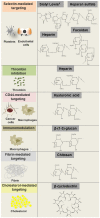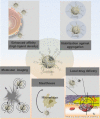Polysaccharide nanosystems for future progress in cardiovascular pathologies
- PMID: 24723980
- PMCID: PMC3982129
- DOI: 10.7150/thno.7688
Polysaccharide nanosystems for future progress in cardiovascular pathologies
Abstract
Natural polysaccharides have received a lot of attention in the biomedical field. Indeed, sources of polysaccharides, extracted or produced from plants, bacteria, fungi or algae, are diverse and renewable. Moreover, recent progresses in polysaccharide chemistry and nanotechnologies allow elaborating new dedicated nanosystems. Polysaccharide-based nanosystems may be designed for interacting in several biological processes. In particular, the atherothrombotic pathology is highly concerned by polysaccharide-mediated recognition. Atherothrombotic diseases, regardless of the anatomical localization, remain the main causes of morbidity and mortality in the industrialized world. This review intends to provide an overview on polysaccharide-based nanosystems as drug delivery systems and targeted contrast agents for molecular imaging with an emphasis on the treatment and imaging of cardiovascular pathologies.
Keywords: Atherothrombosis; Drug delivery; Molecular imaging.; Nanosystems; Polysaccharides.
Conflict of interest statement
Competing Interests: The authors have declared that no competing interest exists.
Figures




Similar articles
-
Polysaccharide-based nanoparticles: a versatile platform for drug delivery and biomedical imaging.Curr Med Chem. 2012;19(19):3212-29. doi: 10.2174/092986712800784658. Curr Med Chem. 2012. PMID: 22612705 Review.
-
Polysaccharide nanosystems for osteoarthritis therapy: Mechanisms, combinations, and future directions.Int J Biol Macromol. 2024 Nov;279(Pt 1):135146. doi: 10.1016/j.ijbiomac.2024.135146. Epub 2024 Aug 30. Int J Biol Macromol. 2024. PMID: 39208912 Review.
-
Algae-derived polysaccharides and polysaccharide-based nanoparticles: A natural frontier in breast cancer therapy.Int J Biol Macromol. 2025 Mar;297:139936. doi: 10.1016/j.ijbiomac.2025.139936. Epub 2025 Jan 15. Int J Biol Macromol. 2025. PMID: 39824414 Review.
-
The European project NanoAthero to fight cardiovascular diseases using nanotechnologies.Nanomedicine (Lond). 2015 Nov;10(22):3391-400. doi: 10.2217/nnm.15.170. Nanomedicine (Lond). 2015. PMID: 26582278
-
Redox Sensitive Polysaccharide Based Nanoparticles for Improved Cancer Treatment: A Comprehensive Review.Curr Pharm Des. 2018;24(28):3303-3319. doi: 10.2174/1381612824666180813114841. Curr Pharm Des. 2018. PMID: 30101696 Review.
Cited by
-
Advanced Drug Delivery Micro- and Nanosystems for Cardiovascular Diseases.Molecules. 2022 Sep 9;27(18):5843. doi: 10.3390/molecules27185843. Molecules. 2022. PMID: 36144581 Free PMC article. Review.
-
Effect of cross-linking on the physicochemical and in vitro properties of pullulan/dextran microbeads.J Mater Sci Mater Med. 2018 May 29;29(6):77. doi: 10.1007/s10856-018-6085-x. J Mater Sci Mater Med. 2018. PMID: 29845352
-
Strategies for the enhanced intracellular delivery of nanomaterials.Drug Discov Today. 2018 May;23(5):944-959. doi: 10.1016/j.drudis.2017.08.011. Epub 2017 Sep 15. Drug Discov Today. 2018. PMID: 28919437 Free PMC article. Review.
-
Nanomedicine as a strategy to fight thrombotic diseases.Future Sci OA. 2015 Nov 1;1(4):FSO46. doi: 10.4155/fso.15.46. eCollection 2015 Nov. Future Sci OA. 2015. PMID: 28031907 Free PMC article. Review.
-
Biocompatible ι-carrageenan-γ-maghemite nanocomposite for biomedical applications - synthesis, characterization and in vitro anticancer efficacy.J Nanobiotechnology. 2015 Mar 3;13:18. doi: 10.1186/s12951-015-0079-3. J Nanobiotechnology. 2015. PMID: 25890231 Free PMC article.
References
-
- Oh JK, Lee DI, Park JM. Biopolymer-based microgels/nanogels for drug delivery applications. Prog. Polym. Sci. 2009;34:1261–82.
-
- Sinha V, Kumria R. Polysaccharides in colon-specific drug delivery. Int. J. Pharm. 2001;224:19–38. - PubMed
-
- Quignard F, Di Renzo F, Guibal E. From natural polysaccharides to materials for catalysis, adsorption, and remediation. Top. Curr. Chem. 2010;294:165–97. - PubMed
Publication types
MeSH terms
Substances
LinkOut - more resources
Full Text Sources
Other Literature Sources

